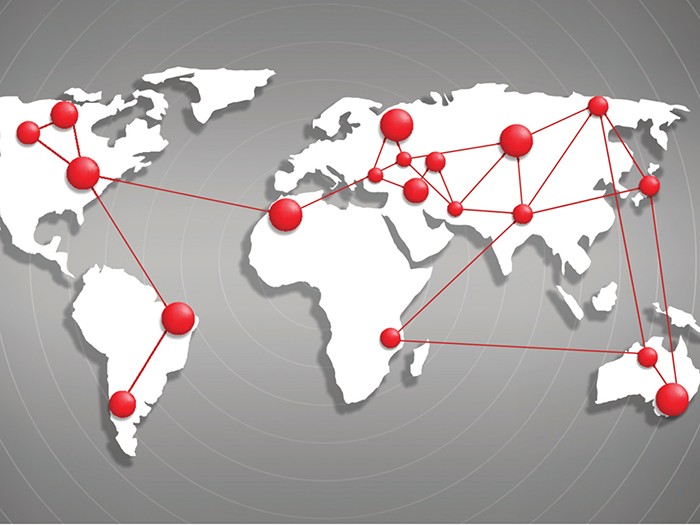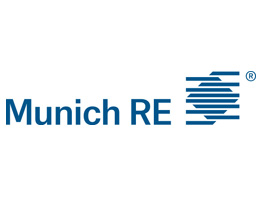Supply Chain Risks
Modeling the Chain

When the massive Tohoku earthquake erupted off Japan’s coast in March 2011, the ensuing tsunami took thousands of lives and more than 125,000 buildings, and caused nuclear meltdowns.
Tucked inside the death and destruction was an issue that spurred a more focused look at using data analytics in supply chain risk management: a shortage of specialty pigment in Japan. That forced automakers — including Chrysler, Ford, Toyota and GM — to temporarily restrict orders on vehicles in certain shades of black, red and other colors.
The pigment, called Xirallic, at the time was produced at only one factory in the world — the Merck KGaA Onahama plant near the Fukushima-Daiichi nuclear power station. The plant quickly was evacuated and shut down. It took months to restart manufacturing and resume deliveries, according to reports.
In the four-plus years hence, the use of data analytics is starting to get traction due to both improved technology and the risk complexity inherent in the supply chain process — as the Japan paint pigment scenario clearly demonstrated.
“Applying analytics to assess supply chain risk is relatively new,” said Erika Melander, manufacturing industry lead at Travelers. “Of course, the main challenge is trying to predict the future in general. We can try and make assumptions about what might happen based on historical data and the trends we expect to see going forward, but nothing is guaranteed.”
Travelers, which has a strong book insuring manufacturers, surveys thousands of accounts each year and analyzes claim trends on a regular basis, said Melander. That process helps Travelers understand how it can help insureds protect their brand and reputation, manage their supply chain risks and keep their employees safe, she said.
“The marketplace is constantly changing and it is crucial for manufacturers to be poised for change so that they can adapt to new laws, materials or customer demands,” she said.
“We can try and make assumptions about what might happen based on historical data and the trends we expect to see going forward, but nothing is guaranteed.” — Erika Melander, manufacturing industry lead, Travelers
Marc Paasch, global head of alternative risk transfer solutions with the Willis Group, said the challenge in using predictive analytics for supply chain risk is taking a very granular approach and quantifying it.
He breaks the process down into hazard risks (CATs, political disruption, etc.), operational risks (key suppliers failing to deliver for one reason or another), financial risks (taking a lean stock approach and running out of inventory due to a
supplier issue) and strategic risks (acquisition of a supplier, resilience of supply chain, etc.).
Anthony Moraes, managing principal at Integro Insurance Brokers in San Francisco, noted that predictive analytics for supply chain is becoming a much
larger factor in his business, which mainly focuses on Silicon Valley.
“We are very involved in tech companies that primarily outsource their manufacturing, so they have large, often complicated supply chains,” he said. “Where they can identify and quantify risks, we can place the coverage, take it to the markets.
“If I had to tell a tech company anything about this issue, it’s that we can get better at supply chain risk management using predictive analytics. That’s the good news,” Moraes said. “The bad news is gathering the best data you can to predict your risk.
“It comes down to, do they really know their own supply chain? If so, good. If not, predictive analytics are not going to be much help to you.”
Hurdles to Overcome
It is all about the data, which is not only difficult to get, but can be subjective and hypothetical.
“A supply chain has a lot of people, places and things associated with it,” said Ben Fidlow, global head of core analytics at Willis Group. “The data is out there, but it may be in 20 different places. Getting an organization to collaborate and offer up their information when they have a siloed view is very difficult.”
Apart from up-to-date, usable data, Willis’ Paasch said, another hurdle is insight into the “elasticity of the flow and price of goods.”
For example, any specific incident may change the whole microeconomic view of the prices of goods and services. The end state of the elasticity of the customer might be fine if delayed a week, but the company could lose customer base if that delay stretches to eight or 10 days.
Organizations need to have someone close to all of the factors so there is a true feel for the potential consequences.
That requires modeling the whole chain, from raw materials to final product. Once the chain is mapped, the organization must focus on every single segment, such as impact on price because of a change in raw materials, impact of delayed transportation or strikes, border issues, and property damage risks.
One large client using a supplier in Indonesia, he said, was discovered to be using children in the production line. It had to close the plant, which created a significant disruption.
Property risks are easier to model, but the impact of compliance risks and unexpected events make modeling supply chains challenging, Paasch said.
“There typically isn’t enough bandwidth or cost justification to be as rigorous with the long tail of other indirect suppliers.” — Kevin Brooks, executive, Ivalua
Kevin Brooks, an executive with Ivalua, an international spend management and procurement solutions provider, cited a study by PricewaterhouseCoopers that found that companies that treat their supply chains as strategic assets achieved 70 percent higher performance in key financial and operation metrics. Yet, the study found, only 45 percent of businesses view their supply chains in this way.
Companies that have experienced a significant supply chain disruption or problem are much more attuned to the issue of supply chain risk than others, he said.
For many, it is a question of both definition and probability, Brooks said. What kind of risk, exactly? Quality? Financial? Performance? And how can the organization adequately assess the likelihood or severity of something happening?
“Most feel they are already capturing some level of risk screening during strategic sourcing, and nearly all manufacturing companies maintain a level of ongoing scorecarding and performance assessment with their top tier suppliers,” he said.
Non-manufacturing companies, however, are less defined about their risk programs unless they are in regulated industries such as health care or banking. And even there, risk assessment happens only with the most strategic tier of suppliers.
“There typically isn’t enough bandwidth or cost justification to be as rigorous with the long tail of other indirect suppliers,” Brooks said.
Solutions Are Improving
Bindiya Vakil, CEO at Resilinc, a cloud-based supplier of supply chain risk and resilience intelligence and analytics, has spent the past decade studying supply chain dynamics. For many companies, she said, supply chain complexity is the No. 1 challenge.
The first step is to identify the most impactful suppliers and part numbers. So, if a supplier delivers 50 parts across 40 products and the result is a billion dollars in sales, it obviously has a major impact should problems occur. On the flipside, you could have a supplier whose revenue impact is high but risk score is very low (financially healthy, good continuity plans in place, safe locations, etc.). That would lessen their risk profile.
“What we find with supply chain is managing risk has been a core goal, but the problem lies in the inefficient processes that cause information to be sketchy and incomplete,” Vakil said. “They say they do supply chain risk management, but once you peel back the onion you will find they are not doing a very thorough job.”
A thorough job requires reaching out to suppliers, including Tier 2 suppliers and maybe beyond, to get information about global locations, the parts being built, and recovery time should problems occur.
“What we find with supply chain is managing risk has been a core goal, but the problem lies in the inefficient processes that cause information to be sketchy and incomplete.” — Bindiya Vakil, CEO, Resilinc
Vakil said Resilinc sees supply chain analytics more as a proactive tool than a predictive one.
“We are not trying to predict the next event, but we can say that’s the right or wrong thing to do should an event happen,” she said. “It’s about discovering where the biggest impact is along the chain and how to manage if something should go wrong.”
At the same time, she added, it’s about being ready to act because there is no way around it: Supply chains are truly risky and the next problem can come from just about anywhere.
“We do an event watch, 24/7 monitoring of the global supply chain with thousands of sources including social media, and anything that can shut down the supply chain,” she said. “No matter what it might be, the issue is: Are you prepared?”
At Travelers, the carrier offers a supply chain pressure test that helps manufacturers identify the links in their supply chain that may be most at risk.
At the end of the test, results are compared to a peer group, and Travelers makes specific resources available based on the test results. According to Melander, some of the latest advances in using analytics to manage supply chain risk include traceability/tracking, demographics, key performance indicator (KPI) reports and big data.
“I would consider supply chain a function of liability and property risks versus a stand-alone exposure,” she said.
“We capture data points that are industry-specific so that we have information that will be helpful to not just food manufacturers, but also at a more granular level, for businesses such as bakeries, dairy product manufacturers or craft breweries,” she said.
“Of course, industries with more complex supply chains will need more analytics.”
Melander cited a large manufacturing insured that used analytics to help identify a weakness in its supply chain with respect to product quality. As a result of tracking warranty claims, the insured noticed that one of its models needed to be serviced more frequently than it would have expected.
While the manufacturer was investigating this, a customer submitted a claim because the product failed and ultimately caused severe bodily injury to one of the customer’s employees.
Because the insured had already identified a potential issue, Travelers’ forensics lab looked at the model in question and identified a specific component that was causing the model to fail. The supplier it had used for the component was the low-cost option.
The manufacturer then changed suppliers. It cost more up-front, but ultimately saved money from warranty servicing. Additionally, putting a safe product into the marketplace allowed the insured to protect its brand.
“Manufacturers especially should constantly use data to re-evaluate their operations and their supply chain practices,” Melander said. “They should also actively engage with their agent or broker and carrier in order to use data to stay apprised of trends and safety practices that are common in the industry.”
Willis’ Fidlow noted that businesses are crying out for expanded analytics tools to manage supply chain, which by its nature represents serious coverage gaps and has been an underserved market because of the previous limits on technology and predictive analytics.
To that end, Willis has been building a mapping solution that uses layered models to help clients manage supply chain risks over various financial periods.
“There definitely is no insurance product right now covering everything,” Fidlow said. “Some pieces are well covered and some fall into gaps.
“In the future, we will be trying to combine it all to increase the footprint of our solution. It’s an evolution, and with supply chain risk getting even more complex due to globalization, it’s also a huge opportunity.”
Insurance carriers are often a key resource for up-to-date data, said Travelers’ Melander, noting that larger carriers often will have information targeted to many industries across the United States and even the across the globe.
“If businesses do not use data available to help manage potential weak links in their supply chains, they are then at risk of losing ground to competitors that are using analytics to help with risk management, and not just for cost savings,” Melander said.














